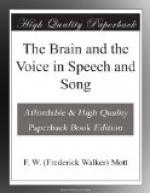The diagram also indicates why these actions of voluntary breathing and phonation can be initiated in either hemisphere; it is because they are always bilaterally associated in their action; consequently both the higher centres in the brain and the lower centres in the medulla oblongata and spinal cord are united by bridges of association fibres, the result being that even if there is a destruction of the brain at a-b, still the mind and will can act through both centres, although not so efficiently. Likewise, if there is a destruction of the fibres proceeding from the brain centres to the lower medullary and spinal centres, the will is still able to act upon the muscles of phonation and breathing of both sides of the body because of the intimate connection of the lower medullary and spinal centres by association fibres.]
Experiments on animals and observations on human beings show that the centres presiding over the muscles of the larynx are situated one in each hemisphere, at the lower end of the ascending frontal convolution in close association with that of the tongue, lips, and jaw. This is as we should expect, for they form a part of the whole cerebral mechanism which presides over the voice in speech and song. But because the muscles of the tongue, the lower face muscles, and even the muscles of the jaw do not necessarily and always work synchronously and similarly on the two sides, there is more independence in their representation in the cerebral cortex. Consequently a destruction of this region of the brain or the fibres which proceed from it to the lower executive bulbar and spinal centres is followed by paralysis of the muscles of the opposite side. Likewise stimulation with an interrupted electric current applied to this region of the brain in monkeys by suitable electrodes produces movements of the muscles of the lips, tongue, and jaw of the opposite side only. Not so, however, stimulation of the region which presides over the movements of




